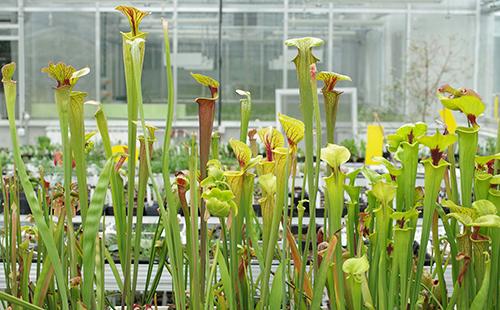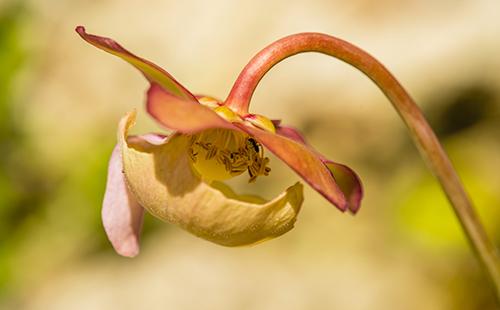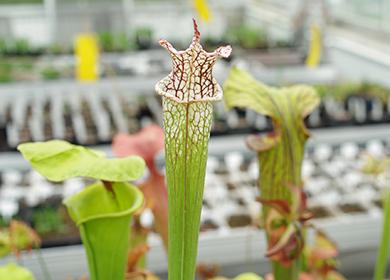The content of the article
Predators of the plant world catch insects by various methods. Sarracenia does not have a sticky unpleasant layer and does not have a trap lock that threatens with sharp teeth. The elegant plant is distinguished by high funnel-shaped leaves, inside of which there is nectar, attracting the victim with its smell. The villi located inside the leaf-tube do not leave the insects a single chance to get out.
Botanical characteristic
Sarracenia is the largest predator plant. America is considered her homeland. The predator perfectly inhabits the swamps of both the Northern and Southern continents. The insectivorous flower feeds on flies, small ants or small spiders.
How to care for sarracene? An American predator cannot be called a simple plant. This insect lover is a very delicate plant that needs special care and certain conditions.
Description
The plant looks very unusual and attractive. In mild European countries, sarracenia is grown as a garden plant. In the conditions of cold winters, a unique American is settled in apartments, on glazed loggias or in greenhouses. A predator plant has the following differences.
- Leaves. Leaves from a rosette grow right from the roots. Each leaf has the shape of a funnel-shaped jug rising vertically upward. Depending on the type, they may have “covers” or “hoods” and vary in color. Most often, tube leaves have a delicate green color with bright yellow, red or purple veins.
- Flowers. They appear with proper care in a three to five year old plant. Sarracenia flowers are also unusual and very beautiful. They are large, 4-10 cm in diameter, and are located on a bare peduncle. The bud consists of five petals-lobes, and in the middle is an umbrella-shaped large pestle. Inflorescences can have a bright red, purple or yellow color.
- Rhizome. The plant has a long and thick root. It can reach 30 cm.
Varieties
The genus sarracenia has ten species, most of which have subspecies. Thanks to breeders, there are hybrids, various varieties and garden forms. They vary in leaf shape, color palette and flower uniqueness. Popular species are collected in a table.
Table - Types of sarracenia and their characteristics
| Name | Characteristic | Flowering features |
|---|---|---|
| Purple | - The plant grows on average by 15-20 cm; - green leaves with reddish veins; - the sheets are narrowed down and expanded upward; - have erect caps | - The flower stalk grows on average by 30 cm; - flowers can have purple, burgundy, purple, pink and even greenish tint; - inflorescences appear in spring |
| Yellow | - Yellow-green tubular leaves reach 60 cm; - ribbed sheets with red veins and cream dots; - some subspecies have copper caps | - The drooping inflorescences have a pleasant aroma; - the flowers may be yellow or with a slight greenish tint; - inflorescences appear in May or in September-October |
| Psittacin | - Aggressive look; - the leaves look like a claw with a canopy-dome; - catching of insects occurs due to their gluing; - the shade of leaves is rich burgundy, almost black | - Flowers are usually red, sometimes yellow inflorescences |
| White leaf | - Tall leaves up to 1.2 m in height; - narrow tubes end with a wavy cap; - leaves are light, almost white with purple streaks; - near the base of green | - The plant produces a peduncle in the spring, approximately in March-April; - flowers are large, red |
Caring for sarracenia: what to consider
If you plan to grow sarracenia at home, then you must fulfill all the requirements of this mysterious and very beautiful sissy. Pay particular attention to watering. After all, the American predator did not accidentally choose wetlands as their place of residence.
Lighting
Sarracenia loves the light. She should "bathe" in the sun eight to ten hours a day. And this applies not only to the summer period. In winter, the beautiful predator also needs adequate lighting. Consider the following wishes of your American guest.
- South windows. The plant is able to easily withstand direct sunlight. And while sarracenia does not need shading on a hot afternoon.
- Lamp lighting. If you cannot provide the plant with a lot of sunlight, then turn on the lamp above it to make up for the lack of natural light. This is especially true in winter.
- Fresh air. This is one of the few plants that is not recommended to be taken out in the summer to a balcony or to the street, since such transfers are not “to her liking”. Although it is necessary to provide a daily flow of fresh air. But at the same time protect the beautiful American from drafts.
Temperature mode
The thermophilic culture willingly grows and develops in moderate room conditions. However, it can withstand extreme heat. And it will not die from lowering the temperature to + 5 ° C. However, it is not worthwhile to subject your predator to such extreme tests. For a comfortable stay in Sarracenia, provide the following conditions.
- Warm period. The plant feels good at a temperature of + 23 ° C ... + 25 ° C. It will be able to withstand the increase in indicators up to + 30 ° С ... + 35 ° С.
- Winter season. With the advent of winter, it is necessary to reduce the temperature of the predator to + 10 ° С ... + 15 ° С. If you do not provide a cold rest, then sarracenia will not be able to fully recover. This will lead to a loss of decorativeness and quick death.
Watering
Sarracenia is a great lover of moisture. But she prefers only filtered or standing water. Rigid, chlorinated can very quickly kill a sissy-sarraceniya. The plant needs to provide special watering.
- "Lower" watering. Sarracenia loves to receive moisture from below. That is why the plant is not watered, but simply put in a basin or pan with water. But you should not keep the pot in a humid environment for a long time, so as not to provoke rotting of the roots. Focus on the ground. The soil should always be moist.
- Watering frequency. In summer, sarracenium is recommended to be watered five times a week. In winter, watering is reduced to three times. But do not allow the earth to dry out.
Humidity
Reviews of gardeners show that having provided sufficient watering, you can practically not worry about air humidity.Your predator will successfully take all the necessary water from the sump. Sarracenia needs a special approach.
- Optimum humidity. For a comfortable life American needs a humidity of 50-60%.
- Spraying - No. Do not increase humidity by spraying. Such procedures adversely affect the health of the predator. The penetration of drops into the "jug" provokes the appearance of brown spots and subsequent decay.
- Valid methods. To increase the humidity in the room, you can resort to using containers with water, pallets with moss, wet pebbles. But remember that the root system should not constantly come into contact with water, otherwise it will begin to rot.
Top dressing
In the wild, the beauty of sarracenia grows in sparse soil. Therefore, the predator learned to do without fertilizers. And any desire to feed her with mineral or organic fertilizers is perceived “with hostility” and immediately begins to wither. Therefore, caring for your sissy, completely abandon the introduction of conventional substances. But if you want to pamper your beauty, then provide her with the following dressings.
- Catching insects. Sarracenia is able to independently feed itself. Strong and healthy plants can be taken out in the summer to the balcony or to the garden, but remember that the American does not really like moving. Open the window or door to the balcony, providing an influx of not only fresh air, but also insects.
- Top dressing. The main supplier of vitamins and minerals for sarracenia are insects. Therefore, if you want to fertilize sarracenia during flowering, you must catch a fly, an ant, a midge or a small spider and throw it in a “jug”.
- Feed rate. Do not overdo it with top dressing. A predator only needs one insect once a month. Therefore, if the plant was taken to fresh air, then completely abandon such an event. Sarracenia takes care of itself.

Transfer
To finally understand how to care for sarracene after a purchase, you need to make out whether it is necessary to transplant the plant right away? Experts recommend not rushing with such a procedure.
A tender predator is very difficult to take root in a new place. If you test it with a transplant, then sarracenia may simply not withstand such procedures. Therefore, gardeners are advised to postpone the transplant until spring. The most optimal period is the beginning of the exit from the rest mode. To properly transplant sarracenia into another pot, adhere to such requirements of a predator.
- Flowerpot selection. Pay special attention to this moment. Sarracenia has a developed root system. Therefore, choose for the predator volumetric flowerpots or special containers with large openings for the outflow of water. Glass or plastic pots are preferred.
- Soil selection. Sarracenia grows in nature on depleted soils. Therefore, you should not select a nutrient substrate for it. But it is important that the soil is sufficiently loose, with good water permeability and a slightly acidic environment. You can prepare the soil from the following components: peat, perlite and sphagnum moss in a ratio of 2: 1: 1.
- Transplant process. There must be a drainage layer at the bottom of the pot. Sarracenia carefully removed from the old pot. The roots are well shaken from the old soil. Remove all dried parts. The predator is transplanted into a new flowerpot and sprinkled with the prepared substrate.
- Follow-up care. Transplanted sarracenia must be watered every day until the plant is fully acclimated to the new conditions.
Breeding methods
Two methods are used to obtain daughter plants. You can propagate the predator by seeds or by dividing the bush during transplantation.Both methods are simple, but require careful and patience from the grower.
Planting seeds
Features. Most often this method is used for the reproduction of sarracenia. After all, a sissy really does not like when she is injured.
Landing algorithm
- Seeds must be cold hardened or stratified. Without this procedure, they will not sprout.
- Initially, the seeds are soaked in water for a day.
- Then they are planted in the ground (a mixture of quartz sand and sphagnum).
- Humidify the soil with distilled water.
- The container is covered with film or glass and put in the refrigerator, in the compartment for vegetables, for one month.
- Twice a week, the film is lifted and moistened.
- After a month, the container is removed from the cold and, without removing the film, put under a phytolamp at a distance of 15-17 cm.
- Soil is constantly moistened and maintained warm (+ 23 ° С - + 28 ° С).
- A month later, the first sprouts appear, only now you can remove the film.
- Young sarracenia need plentiful lighting up to 16 hours a day.
- Young predators grow very slowly, so you can plant them in separate pots only after a year.

Bush division
Features. This method is allowed to be used only for adults and strong plants. The best tolerance for division of the bush is yellow sarraceniya.
Breeding algorithm
- During the transplant, plants must be carefully cut into two or three parts.
- Each of them must necessarily contain a growth point and root system.
- Now you need to prepare the pots and plant the sarracenia.
- At first, provide high-quality and plentiful watering.
Problems and diseases
A plant that has been provided with proper care is practically unaffected by disease. It can become a preventive trap for insect parasites and protect all indoor flowers from pests. But if mistakes were made in leaving, then a wonderful sissy will demonstrate all her capriciousness.
The main difficulty in controlling pests or diseases is the ban on spraying. No substances should enter the jug: neither folk remedies, nor insecticides. Therefore, the spraying procedure is replaced by wiping. The table contains descriptions of the main plant diseases.
Table - Problems of sarracenia and treatment methods for predators
| Symptoms of a Problem | Cause | How to eliminate |
|---|---|---|
| - The plant stops growing; - a gray coating appears on the sheet plates | - Gray rot | - Cut all damaged areas; - arrange daily airing of the room (but not a draft!); - treat the plant with Fitosporin M or Fundazol |
| - Sarracenia begins to wither; - small pests are visible on the plant | - Aphids | - Increase the humidity in the room; - lower the temperature; - Hang a flypaper for catching insects; - remove visible pests; - cut the damaged areas; - gently wipe the sheets with soap and water; - in case of severe damage, use insecticides: Fitosporin, Aktara; - if the mealybug is affected by the roots, transplant into a new disinfected soil and remove the affected roots |
| - Deterioration of the appearance and growth of the plant is accompanied by the appearance of lumps of cotton wool on the leaf | ||
| - Leaf plates turn yellow and dry; - sarracenia entangled in a thin cobweb |
So that caring for sarracenia in a pot is not accompanied by the appearance of problems and diseases, carefully monitor the condition of the green predator. Sarracenia will definitely let you know about mistakes in care. Yellowing foliage indicates a lack of light or an excess of potassium in the soil. And the lack of flowering and drying can signal an improper wintering or insufficient watering. But if the roots or leaves begin to rot, then the watering was excessive. Transplant sarracenia immediately and moderate soil moisture.
Florist reviews
I have been living with sarracenia for 2 years, and through trial and error I have established the following: I recommend urgent transplantation after purchase (I transplanted into normalized peat with sand, sphagnum moss and charcoal) Content: cool in winter, 15-20 in the afternoon and 10-15 at night ( indicators are approximate, I have it on the windowsill) In the summer, in the open air. Lighting: bright diffused light, direct sunlight with a slight shade (for example, tulle) Watering: Rain, distilled or filtered water. Water often, abundantly, to prevent drying out of the substrate and at the same time stagnation of water in the pot and in the pan. Does not tolerate hard watering !!!!! (I water with filtered water). Top dressing: not required; fertilizer application prevents the formation of trapping jugs. She catches flies herself, on the surface of the "jugs" droplets of liquid (like nectar) are formed on the veins. It smells strongly, honey, it tastes sweet. I saw it myself, a huge fat fly flew down and sat on the base of the “jug” and began to drink “nectar”, so gradually in 20 minutes it went up to the “entrance” of the jug and slipped there, rummaged there and gradually fell into the “digestive juice”. P. S. I do not pour water into jugs.
Chef, http://homeflowers.ru/yabbse/index.php?showtopic=3481
I have been living with sarracenia for two and a half years. It turned out to be a rather unpretentious plant. Despite the fact that everyone writes that the water in the pan does not stagnate, I have this plant constantly with water in the pan and for how many years there have been no problems with this. In fact, all this time she stood on the windowsill, on the north side. And she liked the place: after the harsh life in the store, her three and a half half-dried tubes turned into a whole “brass band”, which was very pleasing in its size and color. Last summer, I took her out into the garden, put her in a small open greenhouse under the shadow of an apple tree. I put the pot with the pallet directly on the ground. She liked the place very much, she built several large tubes, intensely fed on insects and even bloomed. Bloomed twice, now again picking up a bud that will bloom soon. After the summer, many of its tubes dried up, I cut them all out (perhaps the reason for this was that the tubes were clogged with dried insects). After this sarracenia gave many new leaves, but they never turned into tubes. I used defended water, I did not apply the filter. In the summer of sarracenia, I also survived calcined suburban well water without loss (I just did not know about the special watering). Now, having again transported this plant outside the city, I decided to use distilled water, and I plan to transplant it according to the instructions.
Lavender lady, http://homeflowers.ru/yabbse/index.php?showtopic=3481
My sarrazenii have a hard wintering. Since autumn, practically nothing remains, except for “crackers” and the bases of pitchers. Recently cut them. New traps grow quickly.
Mihail m, http://frauflora.ru/viewtopic.php?t=8493
My sarracenia winter in the fridge. In the spring I took mine from the refrigerator. A couple of jugs had to be cut off !!! I did not notice in time that she was pushed to the very wall of the refrigerator and she froze a little. Along with the package stuck to the wall. But basically it looks good !!!!!
Cheremisova Galina, http://forum-flower.ru/showthread.php?t=66&page=8

